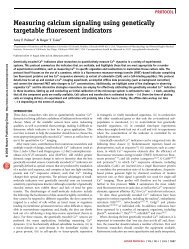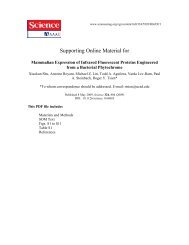THE GREEN FLUORESCENT PROTEIN - Tsien
THE GREEN FLUORESCENT PROTEIN - Tsien
THE GREEN FLUORESCENT PROTEIN - Tsien
Create successful ePaper yourself
Turn your PDF publications into a flip-book with our unique Google optimized e-Paper software.
526 TSIENisomerization (7, 52). The slight difference in absorbance wavelengths betweendenatured and intact proteins is not unreasonable for the structured environmentof the latter. In particular, Arg96 puts a positively charged guanidinium quiteclose to the carbonyl group of the imidazolinone. This cation would electrostaticallystabilize increased electron-density on the carbonyl oxygen in thechromophore’s excited state. This electrostatic attraction would explain muchof the red shift of intact protein relative to denatured protein. Indeed, mutationof Arg96 to Cys in S65T blue-shifts the excitation maximum from 489 to 472nm and the emission maximum from 511 to 503 nm (R Ranganathan, personalcommunication), supporting a major role for Arg96 in lowering the energy of theexcited state. Theoretical calculations of the energy levels of the chromophorein vacuo have led to the proposal that the imidazolinone-ring nitrogen adjacentto the hydroxybenzylidene must be protonated (53). However, the large effectson the chromophore of buried water molecules and the microenvironment suppliedby the protein (52) would seem to provide a chemically more plausibleexplanation.Two-Photon ExcitationOne of the most promising new techniques in high-resolution fluorescence microscopyis two-photon excitation (54), in which two infrared photons hit afluorophore within a few femtoseconds of each other and sum their energy tosimulate a single photon of half the wavelength, that is, ultraviolet to blue. Suchcoincidence of infrared photons requires extremely high fluxes and thereforeoccurs to a significant extent only at the focus of a microscope objective of highnumerical aperture, illuminated by a pulsed laser. Because other regions of thespecimen are effectively not excited, they neither emit fluorescence nor are subjectto photobleaching or photodynamic damage. As in confocal microscopy,the image is built up by scanning the focus point in a raster, but unlike confocalmicroscopy, out-of-focus planes are protected from bleaching, which is atremendous advantage for two-photon excitation.GFPs are quite good fluorophores for two-photon excitation. Wild-type GFPis readily excited with 780- to 800-nm pulses (43, 54–56), which are in theoptimal output range for commercial mode-locked titanium-sapphire lasers.However, the photoisomerization proceeds just as with 390- to 400-nm singlephotonexcitation (55). Class 3 (neutral phenol) GFP mutants have not beentried but should be better because they disfavor photoisomerization. S65T, theprototypic class 2 GFP mutant, is optimally excited near 910 nm and has aslightly higher two-photon cross-section than the wild type (54). Two-photonexcitation is also effective on class 6 (imidazole) blue mutants (43) as wellas class 5 (indole) cyan mutants (H Fujisaki, G Fan, A Miyawaki, RY <strong>Tsien</strong>,unpublished observations).






